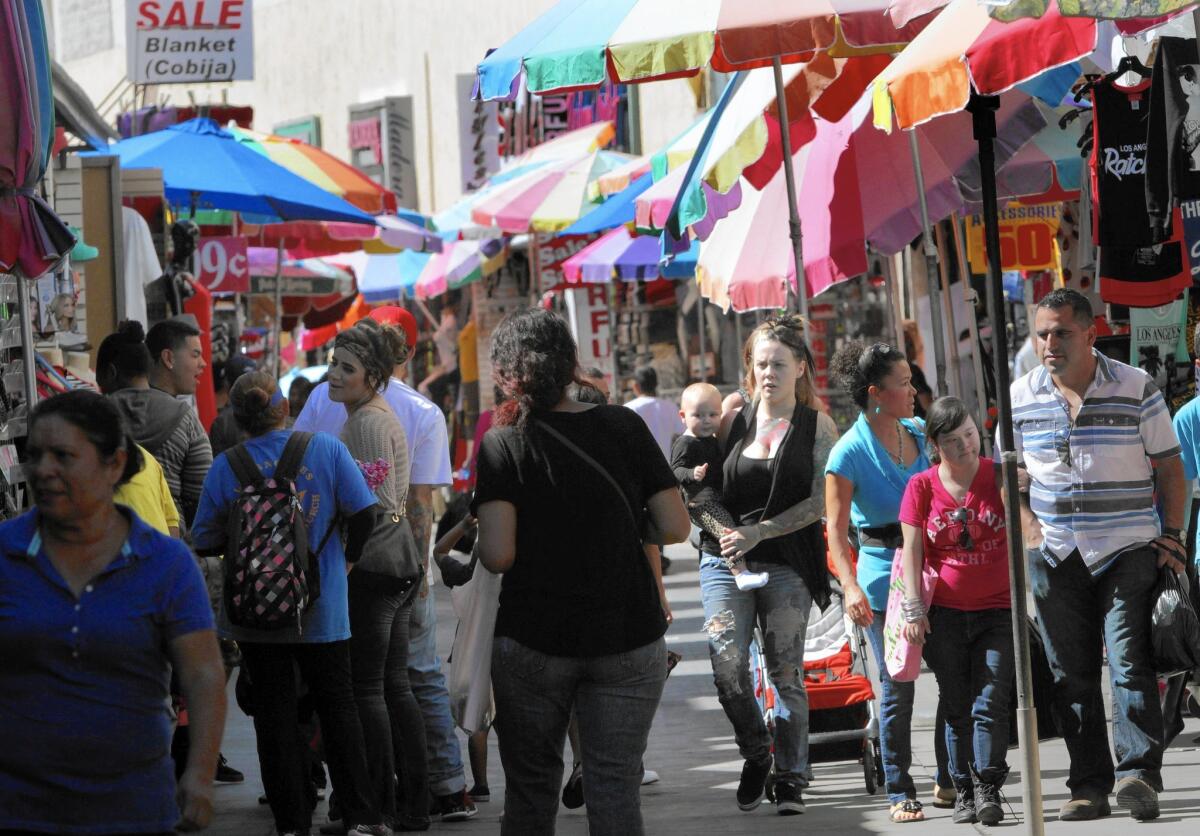Southern California is hotbed for wage theft in garment industry

- Share via
At P & Young Apparel Inc. in the Los Angeles garment district, the clock keeping tabs on sewing workers’ hours was regularly unplugged.
Company time cards showed more than a dozen employees all clocked in within two minutes of one another — a telltale sign of payroll falsification, according to investigators with the U.S. Department of Labor. This spring, an investigation found that 15 employees were owed more than $33,000 for unpaid work.
The case was one of 239 Labor Department wage theft investigations involving garment industry employers during the last fiscal year. More than 90% of the cases — 221 — were in Southern California.
Investigators found that 1,549 local garment workers were owed more than $3 million in unpaid wages — an average of $1,900 per laborer, the equivalent of five weeks of typical pay.
The cases revealed Los Angeles workplaces with “all the features of a sweatshop,” said David Weil, administrator of the department’s Wage and Hour Division. Some had shaky elevators with flickering lights. Sewing employees were paid 9 cents per piece of clothing stitched — a rate that often falls below minimum wage. Some employees’ pay stubs could be redeemed only at check cashing stores that charged fees.
Andy Young Lim, the owner of P & Young, could not be reached for comment.
Experts say intense competition among garment manufacturers has created incentives for companies to shortchange workers, many of whom are undocumented immigrants hesitant to report labor abuses.
As garment manufacturing has migrated to low-wage countries such as Bangladesh, the number of factories in Los Angeles has been cut in half in two decades, to 2,174 businesses and 46,133 workers last year, according to the Bureau of Labor Statistics.
Still, garment businesses are the second-largest manufacturing employer in the region behind transportation equipment producers, according to the Los Angeles County Economic Development Corp. Average weekly wages in the industry are $673, well below the countywide average of $1,161.
The contractors targeted by the Labor Department supply some of the nation’s most recognizable retailers, including Macy’s, JC Penney and Kohl’s. The Los Angeles garment industry runs on a system in which retailers order from manufacturers, who rely on a network of subcontractors to cut, dye, sew, trim and finish items. Profit margins are slim and competition is intense.
“Everyone now wants things made in the USA., but they want it at the same price or just 10% higher than what they’re paying in China or Mexico,” said Ilse Metchek, president of the California Fashion Assn.
Some factories don’t pay workers compensation, while others give employees cash for overtime work, Metchek said. But overall, she said that the local industry is scrutinized heavily by regulators and that most subcontractors working with major brands are registered with the state.
“There are factories that just do things on purpose because it’s cheaper to pay the penalties than pay the people, but let’s not categorize it as people standing there with a whip,” Metchek said. “Rampant worker mistreatment is a mischaracterization.”
Weil, however, said wage theft is “baked into the economics of the industry” in Southern California.
Of more than 1,600 Labor Department investigations into the Southern California garment industry since 2009, 89% found violations. The department has recovered more than $15 million in back wages for nearly 12,000 Southern California garment workers since 2009.
Some workers, such as Juan Hernandez, 23, file claims with the California Division of Labor Standards Enforcement. In seven years, the Guatemala native has worked as a sewing employee in some 40 factories, he said in Spanish through his attorney, Kevin Kish. At most sites, the bathrooms were filthy. Once, he was pushed to the ground by an angry supervisor.
Almost all the facilities paid him per piece stitched— a quarter for a normal T-shirt or as little as two cents for a simpler garment. Laboring for 50 to 70 hours a week — Monday through Friday and a half day on Saturday and sometimes Sunday — would earn him about $300, always paid in cash.
Hernandez filed his complaint after being fired for seeking a raise, he said. The claim was ultimately settled.
“I don’t mind the work and even like it, but sometimes I feel ashamed because of the conditions in which I work and the amount I’m paid for it,” he said. “But you get used to it, and you have to do it.”
For garment workers, wage theft takes many forms: Employers pay workers a smaller rate than agreed, sometimes below minimum wage. Employees are stiffed on overtime and sick pay, have their break times shaved down or are forced to complete tasks before clocking in or after clocking out. Others say the cost of uniforms is unfairly deducted from their paychecks or that they’re penalized after reporting workplace violations.
The complex system of garment suppliers makes it difficult to hold any one company responsible, workers’ advocates argue.
“Everyone is sort of washing their hands of responsibility, and workers are left with sweatshop wages,” said Marissa Nuncio, director of the Garment Worker Center, a downtown group that wants to improve working conditions in the industry.
Rose Buompensiero, 52, was working as a customer service manager at Fluxxus, a manufacturer of upscale women’s clothing in the fashion district, when her weekly paychecks started bouncing in late 2011.
When her bank would no longer accept the checks, Buompensiero went to a check cashing service, only to eventually be turned away as well. Her only recourse was redeeming the checks for a $50 fee at a local liquor store, where her boss had struck a deal with his friend, the store’s owner.
In early April, she came into the office to find that her boss, a Canadian citizen, had cleared out the facility, taking computers and other equipment and leaving the rest in disarray. The Montebello resident is still owed $2,000 for two weeks of pay.
But the real victims, she said, were the manufacturing employees.
“They really get horribly abused,” she said.
Although workers can seek restitution through federal or state agencies, advocates describe the system as slow and overburdened.
A report this year by the UCLA Labor Center and the National Employment Law Center found that it is very difficult for workers to recover unpaid wages, even when the state rules in their favor. From 2008 to 2011, workers recovered only 42% of about $390 million in unpaid wages verified by the state, the report concluded.
In some cases, the businesses dissolve or change ownership, complicating the legal process of getting back pay.
“For so many workers, they’re holding a piece of paper that is essentially just a moral victory,” said Tia Koonse, legal and policy research manager at the UCLA Downtown Labor Center.
California Labor Commissioner Julie Su acknowledged that there have been delays in getting payments to workers who win judgments. The state, she said, is trying to get money to victims more quickly through pre-judgment settlements or fines that can be distributed to workers.
“We’ve tried to be more aggressive,” she said.
A bill that would have allowed victims of wage theft to file property liens against employers died on the state Senate floor this summer. AB 2416, authored by Assemblyman Mark Stone (D-Scotts Valley) and backed by the Service Employees International Union, sought to offer low-wage workers more ways to recover back pay.
For more than a decade, California law has held garment manufacturers liable for wage violations by their contractors. The legislature passed a bill this year that extends similar liability to other industries with contracted workers, such as the warehouse sector.
Weil of the Labor Department said the government is pumping up its efforts to prevent mistreatment. But his division has only 1,100 investigators to monitor 7.3 million workplaces.
Instead of waiting for complaints to spark investigations, Weil said his team is trying to be more proactive about finding violators through unannounced visits and stakeouts.
The department is also increasingly pressuring the manufacturers and retailers at the top of the apparel supply chain to self-police and lean on their subcontractors to properly treat workers.
“If you just go and focus on that bottom level, you’re going to be chasing your tail,” Weil said. “For a long time, we did that.”
Twitter: @tiffhsulatimes, @c_kirkham
More to Read
Inside the business of entertainment
The Wide Shot brings you news, analysis and insights on everything from streaming wars to production — and what it all means for the future.
You may occasionally receive promotional content from the Los Angeles Times.












